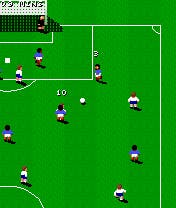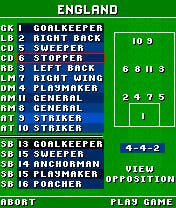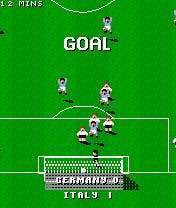Sensible Soccer
The 16-bit classic is back - on mobile phones.
Football is a game designed by masochists for masochists. Any game where you spend approximately 98 per cent of the time watching it engaged in a perverse sort of hell has to have something very wrong with it indeed. But that's enough about your correspondent's lack of Pro Evolution Soccer skills; there was a strange and mystical era in the late '80s/early '90s when football games were purer, more instantly enjoyable, simpler yet deceptively deep and didn't require the sort of combo knowledge that would scare off the average Street Fighter II fiend. In many ways, the likes of Sensible Soccer and its sparring partner Kick Off 2 really were God's Football.
And when we reverentially refer to this peculiar sub-genre as God's Football, we're not getting all misty eyed and Retro-Sexual about the Good Old Days. We mean, of course, that you played the game from the once fashionable overhead, top down, from-the-Gods viewpoint. And there's a damned good reason for this too. You see, when the wise old beings cast their eyes down upon the hallowed turf to check out the latest scores they're not getting touchline player-cam views and behind-the-goal replays; in heaven you see a 22 man tussle of biblical proportions. A curious sort of pinball if you like.
The dream revived

But in the mid-'90s when 3D graphics starting spinning their evil web and game developers pursued the mindless obsession that better graphics meant better games, God's Football dream was over. Top down footy was no more [pfft, only way to play Actua in my house! -Tom], despite being a viable sub-genre in its own right. Some (Kick Off 2002 springs to mind) tried to revive the premise by allowing 3D footy games to be switched to this once-celebrated viewpoint, but frankly cocked it up so badly that no-one even bothers anymore.
So when Mr Sensible himself Jon Hare teamed up with various other Britsoft legends from The Bitmap Brothers and Hewson to form Tower Studio - and port Sensible Soccer (and others) to mobile phones - this was evidently a project worth paying attention to.
So with Sensible Soccer now done and dusted and available to buy now from various operators, we were more than happy to finally get to grips with one of our all-time favourite games and see how they managed to squeeze the game into the confines of a mobile phone.
On the ball

Preloaded onto a Nokia 6600 handset, the game comes in a series of flavours from the standard friendly to definable cups that let you play up to five knockout rounds, and also gives you the ability to include teams of five grades of skill (or not), and customisable leagues for up to eight teams where you can play each other up to ten times with either two or three points for a win. Game time, however, is one element that you can't fiddle with, strangely, with each taking roughly three minutes to play.
If you can't be bothered to mess around with settings, there are four preset cups and leagues of increasing difficulty comprising Pushover, Sensible, Tricky and Hardcore, with eight teams in the cups and four teams in the league; so plenty to get going with.
On the other hand, gone are the days when games like Sensible could get away with having real team and player names, and so we're restricted to international teams comprised of nameless players that are only identifiable by their role/position; thus you get a standard list of players called, for example, Goalkeeper, Playmaker, Striker, Anchorman, Winger and so on, with nine different formations to choose from. It's hardly a deal breaker not having the player names, but nevertheless a shame that such petty licensing restrictions exist at all.
Right at home

The game itself has been a massive challenge to convert thanks to some of the huge hardware limitations that all mobile developers still face. On a visual level the game was never going to be that hard to convert, being as it was one of the simplest titles of its era, with basic stick men, precious little animation and a scrolling green pitch never the most taxing things to render. With full colour games at a reasonable resolution now pretty much the norm for handsets released over the past couple of years, Sensible Soccer is right at home on such technology although does move at a noticeably reduced frame rate. It's still perfectly playable, mind.
Possibly the most noticeable differences in visual terms, of course, are the actual screen dimensions, which mean you're playing in an area that's basically the reverse of what the game was designed for; or in other words you now get to see less of the pitch width than before, but more of its length, which arguably creates as many advantages as disadvantages. It's not something that makes the game feel any different to play though, and that's the most important thing. The actual game graphics are remarkably faithful, albeit with less of the incidental animations that went into the Amiga originals we know and love.
The most obvious compromise is the four-way control which Tower has been forced to shoehorn the game design around, and one that - to be fair - takes a fair bit of getting used to before you can really play the game to any degree of skill. Playable either via the directional keys or the central joystick nub (if available), players run in a given direction unless you change it for them, with the up arrow/hash key acting as pass/slide tackle, and 9 key as kick/shoot. Aftertouch is performed much the same way as before, with a nudge of the opposing direction adding a little bit of bend to a shot, while lob is pulled off by pulling back as you kick. But, like we said, it takes a fair bit of getting used to and in truth you have much less control over your game than veterans would demand.
Practice makes perfect
But repeat play does bring its own success, especially against the weaker skill levels where you'll be given a far greater degree of leeway than the ruthless four and five star teams. One of the key things to get to grips with is intercepting runs and lofted ball with sliding tackles and diving headers. As ever they're hugely disproportional and unrealistic, but work brilliantly in the context of God's Football, and add a great arcadey feel to the game. After a time it does begin to feel just like the old Sensible that took up so many hundreds of hours back in the day, right down to the brandishing of tiny yellow cards, swift goal replays and cute celebrations.
Realistically we're going to have to wait for standard phone handset tech to move up another notch before we can get the perfect conversions we demand and long for, and we'd be the first to admit that mobile gaming isn't quite ready to be fed to the Lion's den that is Eurogamer. We're too picky, too demanding and want things to be just so, so we're probably being unfair to expect any more given the straitjacket of the technology these teams are writing to at present. But, for now, for those of you who do delve into mobile phone gaming and spent years living out your footballing dreams in the 16-bit era, this is a great reminder of a timeless classic and for the sake of a few quid is well worth downloading - if only to recapture the glory days in those stolen tube and bus journeys on the way to work.
This is a score based on the relative merits compared to other mobile football games. As opposed to, you know, ostriches or something. It's actually better than at least half of the ostriches we've met or slept with. Cooks a mean full English, too. Plus: nice hair.








